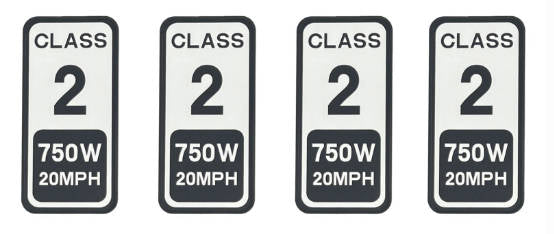The world of electric bikes is buzzing with excitement, offering a fantastic way to commute, explore, and stay active. But with different types of ebikes come different rules of the road and trail. That's where Class 1, 2, and 3 ebike stickers come into play. They might seem like a small detail, but these unassuming labels are crucial for legal compliance, safety, and ensuring a smooth riding experience. Let's break down why these stickers are a must-have for every ebike owner.
Understanding the Ebike Classifications (A Quick Overview):
Before we dive into the "why," let's quickly recap what these classes mean from a legal and regulatory standpoint (keep in mind that specific regulations can vary by state and locality, so always check your local laws!):
- Class 1 Ebikes: These are pedal-assist only, meaning the motor only engages when you're pedaling, and it cuts off once you reach 20 mph.
- Class 2 Ebikes: These also have a motor that assists while pedaling, up to 20 mph. However, they also feature a throttle, allowing you to propel the bike without pedaling (up to 20 mph).
- Class 3 Ebikes: These are pedal-assist only, but the motor can assist up to 28 mph.
These classifications aren't just arbitrary; they dictate where you can ride your ebike and how it's regulated. Many states and local authorities have specific rules regarding trail access, bike lane usage, and even age restrictions based on these classes.
Why Slap That Sticker On? The Key Reasons:
-
Legal Compliance is Non-Negotiable: This is the most fundamental reason. Many jurisdictions require ebikes to be clearly labeled with their class. Without the sticker, you could face warnings, fines, or even be prohibited from riding in certain areas. Think of it like the license plate on your car – it identifies your vehicle and its legal status.
-
Clear Communication for Everyone: The sticker isn't just for the authorities. It provides instant information to other cyclists, pedestrians, and trail users about your ebike's capabilities. This helps manage expectations and promotes safer interactions on shared pathways. Someone seeing a "Class 3" sticker might anticipate a faster-moving bike, while a "Class 1" sticker indicates pedal-assist only.
-
Trail and Path Access - Know Your Limits: Many trails and bike paths have specific rules regarding which classes of ebikes are allowed. Displaying your ebike's class clearly ensures you're adhering to these regulations and helps avoid any confusion or potential conflicts with trail management or other users. Nobody wants to arrive at their favorite trail only to be told they can't ride there.
-
Resale and Ownership Transfer: When it comes time to sell your ebike, having the class clearly marked can significantly streamline the process. Potential buyers will immediately know the bike's specifications and legal classification, making the transaction smoother and building trust.
-
Insurance and Liability: In some cases, having your ebike properly classified and labeled might be relevant for insurance purposes. It clearly defines the type of vehicle and its intended use, which could impact coverage.
-
Peace of Mind and Responsible Riding: Ultimately, displaying the correct ebike class sticker demonstrates responsible ownership. It shows that you understand the regulations and are committed to riding legally and respectfully in shared spaces. It's a small step that contributes to a more organized and safer ebike community.



